DMM Aneng AN8002

This is a cheap DMM with all common function.
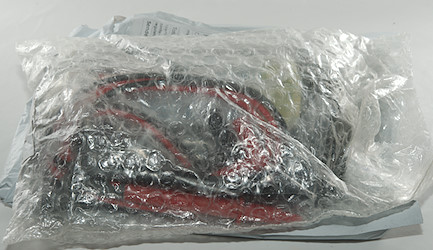
There was no box included with the DMM, only a plastic bag with everything inside.
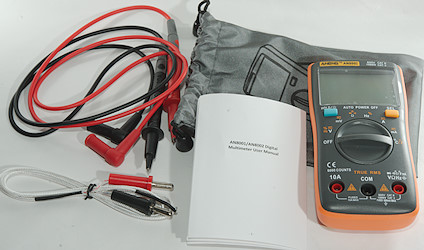
It included the DMM, a pair of probes, a thermocoupler, a bag and a manual.


The standard probes has removable tip covers.
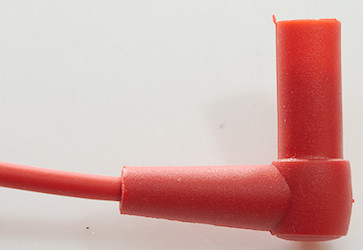
The plug is fully shrouded.


The thermocoupler is the usual cheap type.
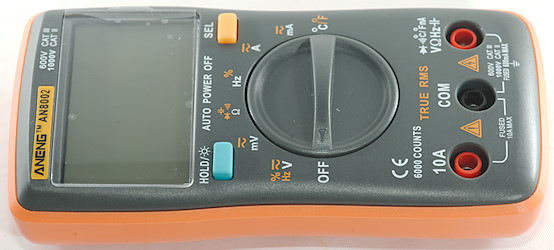

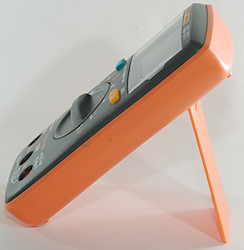
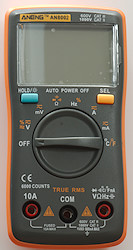
The body of the DMM feels solid, the plastic is rather smooth, i.e. the DMM can easily slide on a surface. The tilting bale is a bit flimsy and do not give enough support for pressing buttons and turning the range switch.
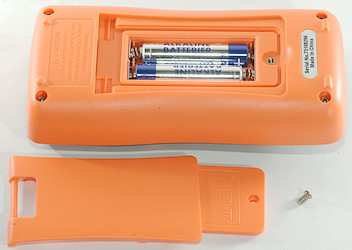
Display
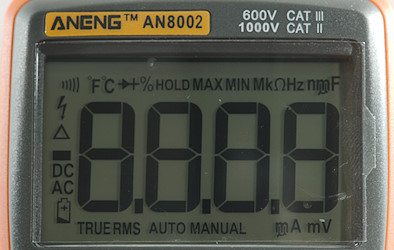
The above picture shows all the segments on the display.
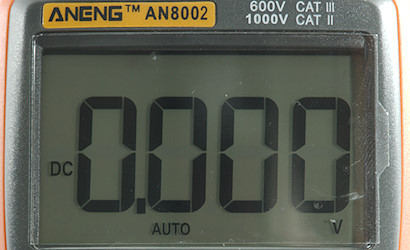
Typical display during usage, it will show the number and what measurement is selected.
Functions
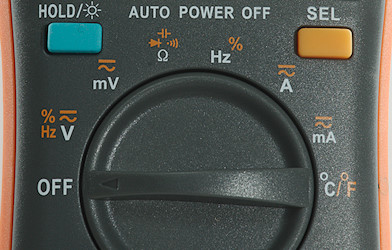
Buttons:
- Hold (Blue): Will freeze display, press again to unfreeze, hold down to activate background light.
- Sel (Yellow): Select the ranges printed with yellow.
Rotary switch:
- Off: Meter is turned off
- V % Hz: Show voltage, using the yellow button will cycle between VDC, VAC, freq. and duty cycle.
- mV: Show millivolt, using the yellow button will cycle between VDC and VAC
- ohm: Resistance, continuity, diode and capacitance, use yellow button to select.
- Hz: Frequency and duty cycle, this is fairly low input impedance above 2V
- A mA: Current AC and DC.
- °C °F: Temperature, will show DMM temperature when no probe is mounted.
Input
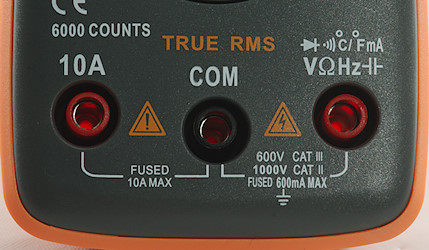
- A: The two A ranges.
- COM: The common terminal for all ranges.
- xxx: All other ranges, including mA. It is always problematic when a current range shares connector with a voltage range, if the switch is in the wrong position the (hard to replace) fuse will blow (at least). This will only affect current, voltage will still work.
Measurements
- Volt and frequency
- 1 VAC is 5% down at 2.1kHz (RMS will not work at the frequency).
- Input impedance is 10-11Mohm on DC and AC
- mV range is high input impedance for DC and 10Mohm for AC below 1.5V, above they wil soon drop to 2kohm
- At 100mVrms input the frequency counter works from 1Hz to 4MHz
- 1Vrms input will extend the frequency range to 7MHz
- Frequency counter and duty cycle need a zero crossing in both Hz and AC range.
- Duty cycle works from 2% to above 99% at 100kHz with 1Vpp, precision is within 0.5.
- V input works with a blown mA fuse.
- Frequency input is 10Mohm below 1.5V and drops to 2kohm at about 3V
- Current
- 10A range is badly calibrated at high current.
- 10A range will change some percent at 5-10A current due to heating.
- 10A range will give an audible alarm when current is above 10A
- 600mA range will give an audible alarm when current is above 600mA
- mA range is protected with 0.6A/250V 3.6x10mm fuse
- 10A range is protected with 10A/250V 3.6x10mm fuse
- Ohm, continuity, diode and capacitance
- Ohm needs about 2.7s to measure 100ohm
- Ohm voltage is 1.0V open and 0.40mA shorted
- Continuity is fast (About 10ms).
- Continuity beeps when resistance is below 50ohm.
- Continuity is 1.0V open and 0.40mA shorted
- Diode voltage is 3.2V with display of up to 3.000V with 0.2mA, maximum current is 1.8mA shorted
- 70000uF takes about 10 seconds to measure.
- No protection level is specified, only that not voltage must be present.
- Miscellaneous
- Current consumption of meter is 1.6mA (7mA with backlight)
- Meter works down to 2.2V where it turns off, battery symbol show at 2.4V.
- Readings are stable with changing battery voltage.
- Backlight only works down to about 2.6V where it is fairly dim.
- Viewing angle is good.
- Display updates around 3 times/sec
- A beeper will sound shortly before the meter turns itself off
- Backlight will automatic turn off in about 15 seconds.
- Will automatic turn power off in about 15 minutes.
- The meter usual need a couple of display update to reach the final value.
- Standard probes fits fine, but cannot be seated fully.
- Weight is 135g without accessories, but with batteries.
- Size is 130.2 x 65 x 32.3mm
- Probes
- Probe resistance 55mOhm for one.
- Probe wire is fairly soft and 65cm long.

A look at the capacitance measurement waveform.

Frequency input resistance. mV looks similar, except DC is high impedance at low voltage.

Tear down
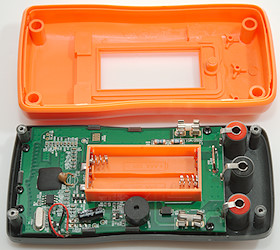
Four screws and the back could be removed.

Three more for the circuit board and two for the display.
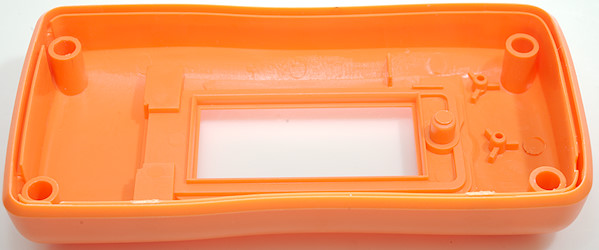
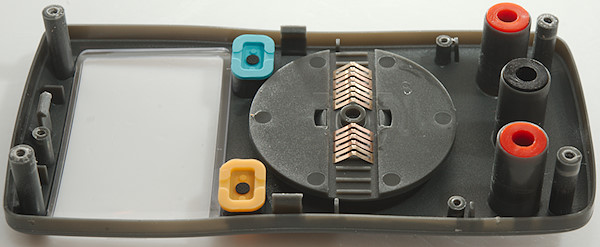
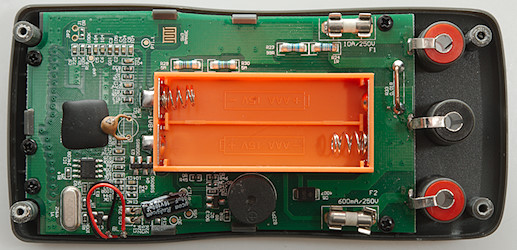
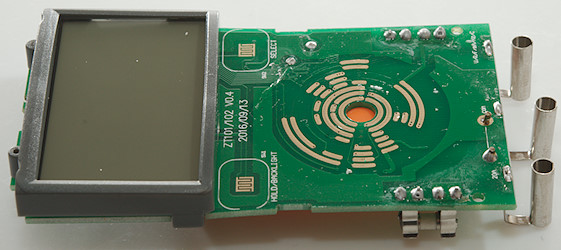
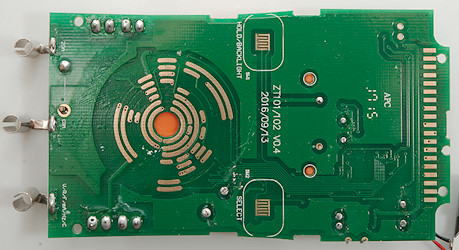
On this side there is only the switches and the connection to the display. The 10A current shunt is missing a solder joint on this side.
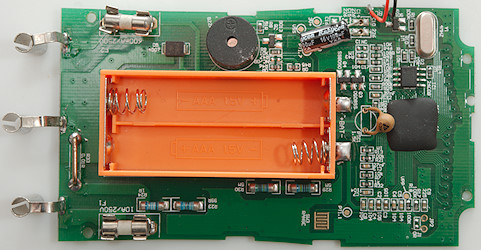
The two small fuses are not designed for high CAT ratings.
R24 is a 1ohm resistor for mA current range and R23 is a 99ohm resistor for the missing uA range. R29 and R30 is the 10Mohm input divider.
D5 is a bidirectional zener diode to protect the mA current shunt.
Q3 & Q4 is input protection together with PTC1. The DMM chip is under the black blob and the IC1 (24C02) beside it is a EEPROM to store functions and calibration in.
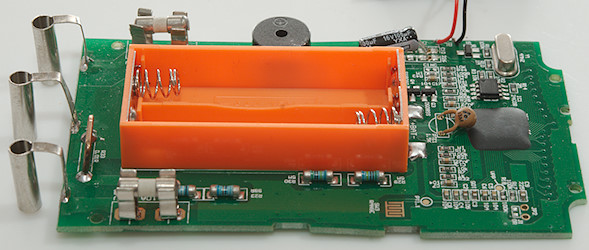
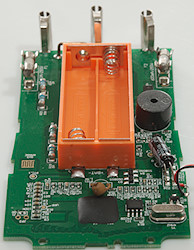
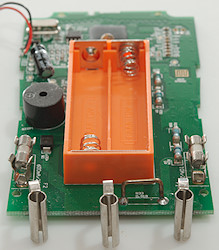

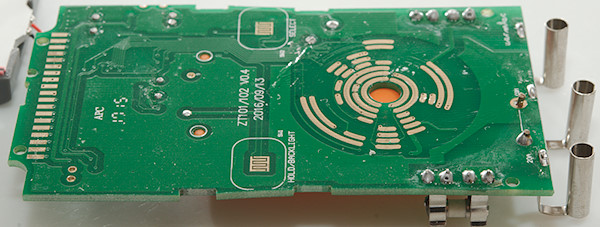
Conclusion
The meter is easily within the specified tolerances (Except 10A) and it has lot of functions and ranges, but the CAT rating is fake.
This is a small DMM in size, but has most of the expected functions in a universal DMM. It is missing the uA current range,
I do not like the small fuse size, they cannot break high voltage or high current and they can be hard to source. The current range on the voltage input is also a bad idea.
I will call it good DMM for hobby use, but keep it away from anything with mains voltage and lots of amps.
Notes
This meter exist with many different names on it and small variations in functions.
How do I review a DMM
More DMM reviews
































